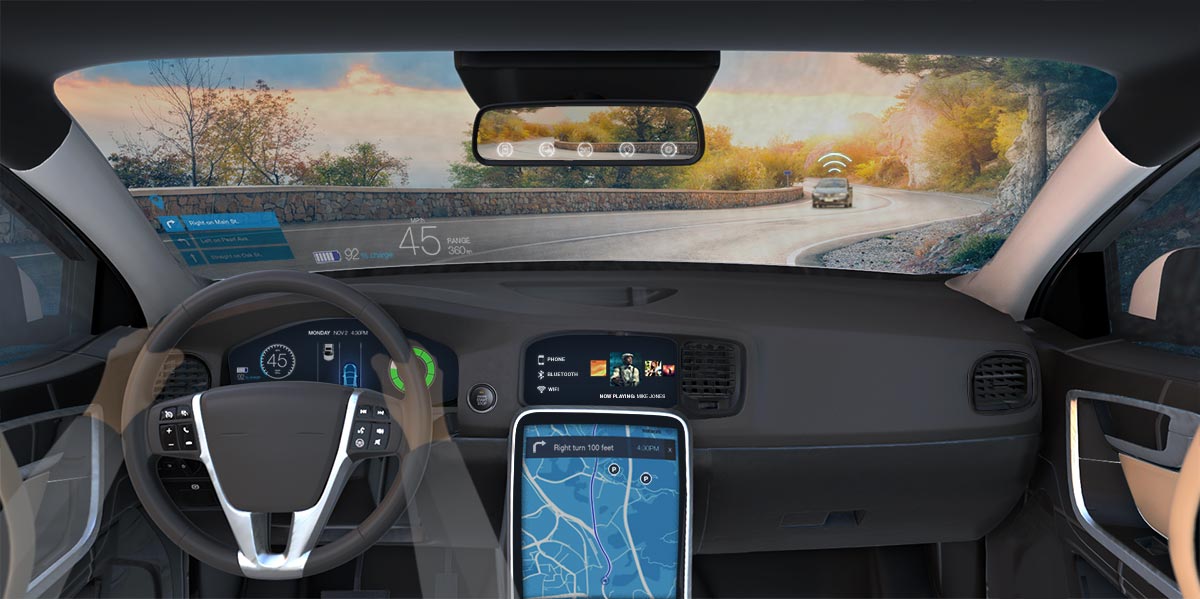SSZT400 october 2019 LM5143-Q1 , LM61460-Q1 , TMP235-Q1
Everywhere you turn, you hear about “cars of the future.” As the automotive industry continues to make leaps to higher levels of autonomy, how will the driving experience evolve when people less actively drive the car?
That is no longer a hypothetical question. As our attention will no longer be directed at operating the vehicle, in-vehicle entertainment will become far more important. Ever-more-impressive infotainment systems already allow the drivers as well as the passengers to gather important information about their car and journey, while also being entertained, and this trend will only continue to accelerate.
Judging from concept cars showcased at auto shows around the world, these infotainment systems will no longer be contained to solely the center console but will instead stretch across the entire dashboard while also including screens on the steering wheel, the backs of front-seat headrests, and even on the windshield with head-up displays, which allow drivers to see directions and other crucial information without taking their eyes off the road. Figure 1 depicts the type of integrated cockpit you might see in the near future.
 Figure 1 Example of an integrated
cockpit you might see in the future.
Figure 1 Example of an integrated
cockpit you might see in the future.These ever-more-complex systems will provide drivers and passengers with an incredible assortment of benefits in the Head Unit or Integrated Cockpit such as navigation, car diagnostic information, wireless and Bluetooth® connectivity, music selection, and video entertainment. All of these functions will require significant data processing. Additionally, the screens used to display this information will not only increase in number and size, but also in resolution, thus requiring more power.
Today, infotainment systems that run off of a car battery typically use 3 A to 4 A to supply power to the processor and displays. This is sufficient for powering only one display; this power level can also sufficiently support the processor. But larger, more numerous displays increase the power requirements accordingly, with many systems requiring 6 A of current off the battery and some elaborate systems requiring 8 A to 10 A.
As a result, engineers need to look for DC/DC buck converter and controller products that offer the power, electromagnetic interference (EMI) performance and efficiency that these types of applications require. With infotainment systems operating off of car batteries, it will become increasingly important to use high-efficiency power solutions to minimize the amount of heat put out by the system.
The LM5143-Q1 is one example of a device that addresses these issues. This low quiescent current two-phase controller has good EMI performance, a key priority for infotainment systems, which helps minimize the amount of noise present near the FM radio (leading to audible noise) as well as near other systems where EMI can affect proper operation. It can also easily support the 8- to 10-A output currents seen in the newest infotainment systems. Given the thermal challenges that arise at these higher output currents, the LM5143-Q1 and its external field-effect transistors offer an appealing solution due to their additional flexibility. Alternatively, the LM61460-Q1 offers a peak efficiency of over 93% at common-load currents (see Figure 2) minimizing thermal dissipation and the chances of thermal foldback activation that can be detrimental to the performance of the infotainment cluster (for instance, by reducing the brightness of the display).
 Figure 2 Efficiency for the LM61460-Q1
Figure 2 Efficiency for the LM61460-Q1To further limit thermal dissipation, engineers can use external temperature sensors in order to stay within the system’s safe thermal design limits. In combination with a high-efficiency DC/DC power solution, accurate and cost-efficient temperature sensors like the TMP235-Q1 can serve as the last line of defense, helping engineers avoid damage to the circuit caused by overheating. Furthermore, temperature sensors can be placed in many typical system hot spots, such as the MPU, power supply or backlight LEDs, to help identify and address potential sources of temperature surge.
The future is very exciting for the infotainment market, with boundless potential. That being said, high-powered infotainment systems also present unique challenges such as thermal dissipation and the need for a reduced total solution size. To get the best performance out of your infotainment system with a given strict thermal dissipation and minimize heat loss at high currents look for high-efficiency, power dense off-battery DC/DC solutions. To ensure a thermal safety margin no matter the operating condition, consider adding accurate temperature sensors in typical system hot spots.
Additional resources
- Read the application note, “IC package features lead to higher reliability in demanding automotive and communications equipment systems.”
- Check out the 30-W power for automotive dual USB Type-C™ charge port reference design.
- Read the technical article, “How to enable thermal safety for automotive infotainment and cluster systems.”
- See the levels of autonomy in this technical article, "Are we there yet? Expectations vs. reality in autonomous driving."